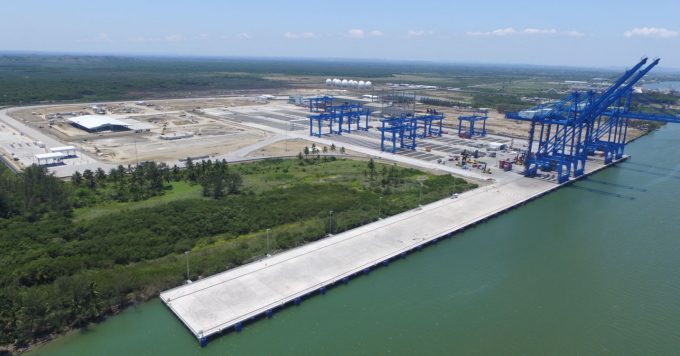Boxes piling into Mexican ports – but then piling up
Mexico’s box ports continue to boost throughput, fuelled by nearshoring and roaring trade with the ...

The spectre of terminal overcapacity is on the rise in Mexico.
A slew of new projects could see terminals on both Pacific and Atlantic coasts scrambling for container cargo, while automotive manufacturers looking for ro-ro capacity are likely to remain woefully underserved.
John Bressi, general manager of Stevedoring Services of America’s (SSA) Tuxpan terminal, told delegates at last week’s TOC Americas Container Supply Chain event in Cancun that some 70.9m teu of new capacity was set to be built across Latin America – the equivalent of around 70% of the region’s total port throughput last year.
“Mexico, Costa Rica, Venezuela, Colombia and Peru have all been identified as trending towards high excess capacity,” he said.
Mr Bressi is overseeing the development of Mexico’s newest port, at Tuxpan, on the Country’s Gulf Coast, and he admitted that capturing volumes immediately after opening would be difficult.
“In the short term it is going to be slow – shippers have to become accustomed to new routes and new services carriers may want to offer,” he said.
However, he also claimed that the longer-term dynamics would turn in its favour.
“I think there’s room for growth on the Gulf coast – there are some niche cargoes that are going to start moving out of Tuxpan’s immediate hinterland when we open.
“At the same time, there are increasing volumes currently moving by road to the US that could move to shortsea shipping services, once we have established routes,” he said.
He said it was a trend which could be further consolidated as vessel sizes in Mexico’s Gulf coast trade begin to increase and shippers see the benefits of greater economies of scale.
“There are a couple of larger ships already coming into the region, and eventually there will be a cascading effect hitting the Gulf coast – and we are currently the only terminal that will be capable of handling these size vessels,” he argued.
When it opens late this year, SSA’s Tuxpan Port Terminal will offer carriers and shippers 800,000 teu of annual capacity.
Whether it remains the only port capable of handling the next generation of vessels to call at Mexico’s Gulf coast will depend on developments at the port of Veracruz.
With container facilities managed by Hutchison, the port is the oldest in Mexico and the government is keen to develop new facilities outside the port area and move Hutchison’s operations there.
If and when this new terminal becomes available, Mr Bressi said, Veracruz was expected to add around 1.5m teu in new capacity to the Gulf Coast.
In addition, Filipino operator ICSTI has a concession to develop the next phase of Tuxpan, which could bring another 700,000 teu capacity.
Current annual capacity across the Mexican Gulf coast is 2.1m teu, in the medium term that will rise to 5.2m teu once the developments listed above have been completed.
Mr Bressi said throughput at Gulf coast ports was projected to reach just under 1.7m teu this year, representing 80% of terminal utilisation.
“With annual projected growth in volumes of just 3%, it’s gong to take the next 37 years to consume all the upcoming capacity addition of 3.1m teu,” he said.
And that is not all. The Mexican government also intends to modernise Altamira.
Mexico’s director general of Merchant Marine, Pedro Bermudez, said: “We are working on a plan to deepen the access channel at Altamira and we can either build new terminals or expand the existing facilities.”
The situation is mirrored on the Pacific coast, where current capacity is 5.5m teu, with this year’s throughput forecast to reach 3.75m teu – or 68% utilisation – with another 3.3m teu capacity set to added.
With a projected annual growth rate of 4%, it will take some 22 years before the additional capacity, mostly set to be built at Lazaro Cardenas, is used.
At the same time, there is enormous investment being ploughed into the country’s automotive manufacturing sector, but little show in the way in the way of ro-ro facilities for those exports. Last year 3.8m cars were produced, which is set to rise to 5m within the next four years.
The overall car handling capacity at the country’s ports is expected to reach 1.4m units by 2017, a glaring shortfall.
Comment on this article